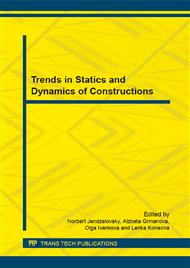[1]
P. J. Tikalsky, D. Pustka and P. Marek, Statistical Variations in Chloride Diffusion in Concrete, ACI Structural Journal, Vol. 102, No. 3 (2005), pp.481-486.
Google Scholar
[2]
P. Konecny, P. J. Tikalsky and D. G. Tepke, Performance Evaluation of Concrete Bridge Deck Affected by Chloride Ingress, Simulation-Based Reliability Assessment and Finite Element Modeling. Transportation Research Record. No. 2020 (2007).
DOI: 10.3141/2028-01
Google Scholar
[3]
D. Vorechovska, J. Podrouzek, M. Chroma, P. Rovnanikova, and B. Teply, Modelling of Chloride Concentration Effect of Reinforcement Corrosion, Computer-Aided Civil and Infrastructure Engineering, Vol. 24 (2009), pp.446-458.
DOI: 10.1111/j.1467-8667.2009.00602.x
Google Scholar
[4]
E. Bentz, M. D. A. Thomas, Life-365 Service Life Prediction Model, Computer Program for Predicting the Service Life and Life-Cycle Costs of Reinforcements Concrete Exposed to Chlorides, (2001).
Google Scholar
[5]
P. Konecny, Reliability of Reinforced Concrete Bridge Decks with Respect to Ingress of Chlorides, Doctoral thesis, 2007, Faculty of Civil Engineering, VSB – TU of Ostrava.
DOI: 10.4203/ccp.101.46
Google Scholar
[6]
P. Ghosh, S. Hanson, D. Thomas, D. Tepke, and P. J Tikalsky, Influence of HPC Mixtures on Diffusion Coefficients, Resistivity and Surface Chloride Concentrations: Proceedings at ICDC 2012: International Congress on Durability of Concrete, June 18-21, 2012, Trondheim, Norway.
Google Scholar
[7]
P. Ghosh, Q. Tran and T. Le, Compressive Strength and Surface Electrical Resistivity of HPC Mixtures, International Journal of Engineering Sciences and Management, Vol. 6, No. 1 (2014), ISSN 2231-3273.
Google Scholar
[8]
P. Lehner, Numerical Solution of 2-D Chloride Diffusion Problem Using FEA, Bachelor thesis, 2012. Faculty of Civil Engineering, VSB – Technical University of Ostrava. (in Czech).
Google Scholar
[9]
P. Lehner, P. Konecny, P. Ghosh and Q Tran, Numerical Analysis of Chloride Diffusion Considering Time-Dependent Diffusion Coefficient, International Journal of Mathematics and Computers in Simulations, Vol. 8 (2014), pp.103-106. ISSN 1998-0159.
Google Scholar
[10]
P. Konecny, J. Brozovsky and P. Ghosh, Evaluation of Chloride Influence on the Cracking in Reinforced Concrete Using Korozeeneck Software, Transactions of the VŠB – Technical University of Ostrava, Civil Engineering Series, Vol. 11, No. 1 (2011).
DOI: 10.2478/v10160-011-0006-y
Google Scholar
[11]
ACI Committee 222, Protection of Metals in Concrete Against Corrosion, ACI 222R-01, American Concrete Institute, Detroit, MI, p.41. (2001).
Google Scholar


